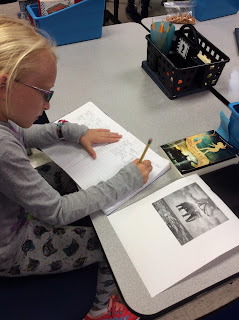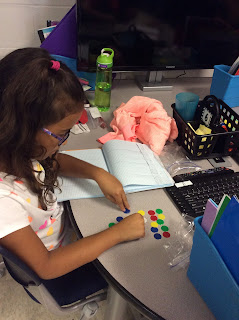Tuesday, October 18, 2016
Monday, October 17, 2016
Weekly Newsletter: Week of October 17th
Click HERE to access this week's third grade newsletter. As always, let me know if you have any questions, comments, or concerns. Have a great week!
Main Idea
Last week, we started discussing the difference between fiction and nonfiction texts. Readers determined that in a fiction text, the author is usually trying to teach you a lesson. In nonfiction, however, the author is trying to teach you about a certain topic. We concluded that this is called the main idea! To begin our work on finding the main idea, students looked at pictures around the room and tried to determine the topic and main idea of the pictures; essentially, how the pictures go together. This week, we will be using the following chart to find the main idea in some high interest nonfiction articles!
At home, encourage your student to expand their reading diet to include nonfiction texts. While reading, go through this list of steps to finding the main idea and practice it together!
At home, encourage your student to expand their reading diet to include nonfiction texts. While reading, go through this list of steps to finding the main idea and practice it together!
Thursday, October 13, 2016
What does independent reading look like?
As an educator teaching in the world of technology, I have had to rethink the way independent reading looks like in the classroom. With the abundance of reading apps and websites and the change in ways our students think and learn, independent reading is different than each student with a chapter book in their hands, flipping the pages as they go. In the classroom and at home, students may read a book online, swiping with their finger to flip the page. You might see them listening to a story being read aloud and reading the words with the reader. A student might also listen to an audio book, forcing them to infer and visualize what the characters are doing based on what they hear.
When reading at home with your student, I challenge you to open your mind to what independent reading can look like.
When reading at home with your student, I challenge you to open your mind to what independent reading can look like.
Michael is using the Epic App to listen to a story being read. He does not have the text in front of him, so he is forced to infer and visualize the story.
Ethan listens to a reader while tracking the words across the page. The Capstone website lights up each word as it is being read, increasing the rate a student may read independently.
Lexi enjoys a good old-fashioned book from the classroom library!
Avery is using Big Universe to read a non-fiction book on tsunamis. This website does not read to the students but gives them high interest books that reinforce independent reading skills.
Tuesday, October 11, 2016
How do writers transform real life moments into a story?
As we begin our next writing piece, writers are first asked to develop story ideas. One way that writers get ideas for fiction is by paying attention to the moments and issues in our own lives. Students learned and discovered that E.B. White got the idea for Charlotte's Web by lying on a bale of hay in his barn, watching a spider in her web. The barn animals, the pigs, and the geese were all around, and he wrote about that moment in his writing notebook.
Writers were asked to look at different pictures around the room and transform those moments into story ideas. After drafting many ideas, they will be asked to choose one that fits the qualities of a proficient narrative to take through to publishing. This is an exciting process and so fun to watch!
Writers were asked to look at different pictures around the room and transform those moments into story ideas. After drafting many ideas, they will be asked to choose one that fits the qualities of a proficient narrative to take through to publishing. This is an exciting process and so fun to watch!
What are text features?
This week, readers dived into non-fiction texts and specifically focused on how the text features help them as a reader. At the end of the week, each student was assigned a text feature and created a Pic Collage poster to share what they know about that text features and it's purpose. All posters were then combined to a Padlet, shown below.
Tuesday, October 4, 2016
Monday, October 3, 2016
Raging Rectangles
Looking for a fun and quick math game to play at home with your student??? Click HERE to download and print off a copy of Raging Rectangles.
What does it mean to multiply?
As we begin to understand what it means to multiply, students are exploring multiplication using different math manipulatives. Third grade standards require students to interpret 5 X 7 as the total number of objects in 5 groups of 7 objects each. For example, you could say "There are 5 students and each student has 7 pencils. How many pencils are there?" When using manipulatives, mathematicians in third grade would create 5 groups of 7 OR an array of 5 rows and 7 columns, then count to find 35.
I know this is very different from the way you and I learned how to multiply, but please praise your student on learning what this operation means, rather than just learning the facts. Their deep understanding of what it truly means to multiply will be amazing and I can't wait to see what real world problems they can solve using this understanding!
At this point, please continue to work on and practice addition and subtraction skills at home while we continue to develop an understanding of this new operation in class.
Below are some pictures from one of our first days working with equal groups and arrays!
I know this is very different from the way you and I learned how to multiply, but please praise your student on learning what this operation means, rather than just learning the facts. Their deep understanding of what it truly means to multiply will be amazing and I can't wait to see what real world problems they can solve using this understanding!
At this point, please continue to work on and practice addition and subtraction skills at home while we continue to develop an understanding of this new operation in class.
Below are some pictures from one of our first days working with equal groups and arrays!
Subscribe to:
Comments (Atom)

















